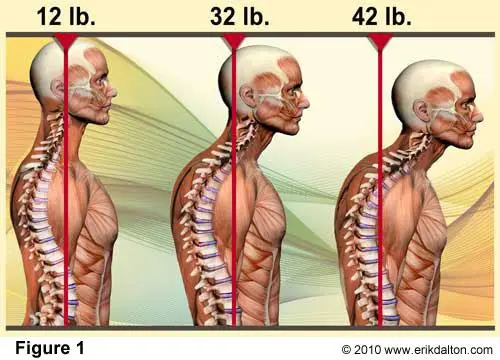Forward Head Posture
A normal head posture is when, from the side view, the centre of the person’s ear is lined up with the centre of the shoulder. Forward head posture (FHP) occurs when the head moves forward from normal posture, with the head drooped forward, and the shoulders rounded. Here’s an example of proper alignment on the left, a 2” forward head posture in the centre, and a 4” FHP on the right.

This poor neck posture puts tremendous strain on the muscles of the back and neck. In fact, for every inch the head moves forward, it feels 10 pounds heavier to these muscles. So if your head is 2” forward, it’s like having a 20 pound bag slung around your neck. The suboccipital muscles are a group of eight muscles at the back of the neck that lift up your chin. These muscles become constantly tight, putting pressure on the suboccipital nerves. This can cause headaches at the base of the skull, or even sinus headaches. FHP can also flattens out the natural curve of the neck, creating accelerated joint degeneration in the cervical (neck) spine, which can lead to neck arthritis. And there is a host of other ailments in which FHP plays a big role: chronic lower back pain, stress-related ailments, spinal pain, especially between the shoulders, pulse and blood pressure problems, and even lung capacity. Forward head posture is very common among people who work at a computer or a desk most of the day, those who slouch down and read in bed, or people who have played contact sports such as football, and the spinal injuries that go along with such sports. Chronically tight muscles and poor flexibility can also lead to FHP and other postural problems.
What are some of the things you can do to relieve and correct FHP? In terms of training, I would first look for tight muscles and range of motion (ROM) to determine what muscle groups need stretching and exercises to improve ROM.
Next, it’s important to address the weak muscles in the upper back, shoulders and neck. Lat pulldowns, rows, and shrugs all strengthen the weak back and shoulder muscles. Strengthening the lumbar (lower back) spine muscles can be done with spinal extensions, Alternate lift, or superman exercises. And don’t forget the abdominal muscle group, to increase strength in the torso and improve posture as well. Planks or other isometric exercises are a good place to start; however, crunches and sit-ups are not recommended because these exercises can encourage forward head posture.
Correcting your posture is key to change here. Here are some ideas:
1.Check your ergonomics in your car, at your desk, on your sofa – is your spine long? If not, focus on bracing or “tucking in” your abdominals, lifting your chest slightly, and keeping the shoulder blades pulled down. You may need to adjust your desk chair and/or the height of your computer monitor, and reposition yourself to achieve a tall spine.
2.Perform chin retractions. Looking straight ahead, drop the chin slightly, and push your chin backward with a finger. Hold for a few seconds, and repeat several times. Do this several times a day to help realign your posture.
3.Whenever you have to sit for long periods of time, get up and walk around every half hour, gently squeezing your shoulder blades together for a few seconds. Do 10-12 times to help correct your posture and counteract the effects of prolonged sitting.
Last, explore professional help such as chiropractic care. This can be invaluable in your efforts to overcome forward head posture and other postural imbalances.